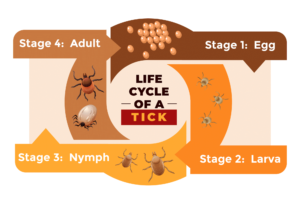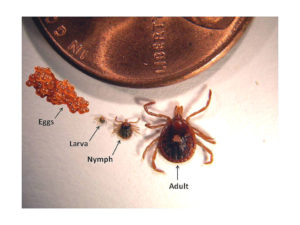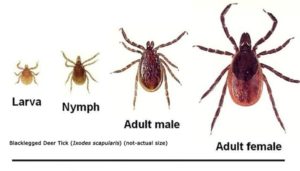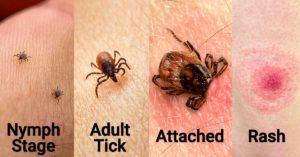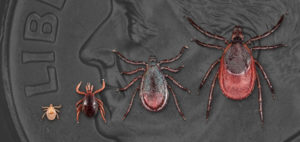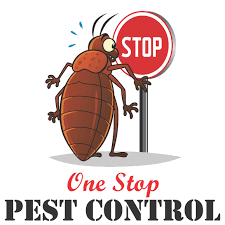READ ALL ABOUT IT
CHECK OUT OUR BLOG FOR CHICAGOLAND & SOUTHERN WISCONSIN
The Life Cycle of a Tick
The Life Cycle of a Tick
Knowing the life cycle of a tick can help recognize it and prevent it from populating near your home. Ticks can, in fact, be active all year long, but they thrive during the wet spring and summer months. As temperatures rise, so do the ticks, and they are on the lookout for their next blood meal. Sadly, the ticks come out as soon as temperatures get enjoyable for us humans to get out after the long Chicagoland winter. Being conscious of the ticks is important if you are headed out for a hike, dog walk, or just spending an afternoon outdoors.
To understand when ticks are most dangerous, it’s crucial to examine their life cycle. Throughout their development stages, ticks exhibit different levels of activity and thus pose varying degrees of risk. For instance, larvae and nymphs are smaller and can be active at cooler temperatures, often going unnoticed due to their size, yet they can transmit diseases just as adult ticks do. Each stage in the tick life cycle reacts differently to environmental conditions, and understanding this can help us better predict and prepare for their peak activity periods. This comprehensive view allows us to anticipate seasonal peaks like those in spring and summer and remain vigilant during the less expected times of the year.
Stage One: Egg Stage
Female ticks can lay thousands of eggs on the ground, quickly hatch into larvae known as seed ticks.” At this stage of life, the small ticks have six legs instead of the eight they will have later on in life. They are about ⅛ of an inch in size. Once females have laid their eggs, they die.
Stage Two: Larvae Stage
Once hatched from their eggs, tick larvae remain near their birthplace, typically climbing onto grass or low vegetation. Here, they patiently wait to latch onto passing small animals such as mice, squirrels, rabbits, and birds. After feeding on these hosts for a period ranging from 2 to 9 days, the larvae drop to the ground, where they digest their blood meal before molting into the 8-legged nymph stage.
During this second stage, the tick nymphs continue their quest for blood. Initially, these nymphs also target smaller hosts similar to those preferred during their larval stage. However, their target hosts expand as they grow to include larger animals, such as deer, pets, and even humans if they are accessible. This marks a significant shift as they pose a greater risk to larger mammals, including our pets and families.
Understanding these host preferences at each stage of a tick’s life is crucial for effective tick management and prevention strategies. These strategies help protect wildlife and domestic animals, including humans, from tick-borne diseases.
Stage Three: Nymph Stage
Just like stage two, the tick larval stage, this third stage depends on an active search for a blood meal. Once the nymphs have molted, they will look for a second host. Nymphs prefer small animal hosts, but they are great potential host substitutes if they can find humans and pets.
Stage Four: Adult Stage
The final stage of a tick’s life is the “adult stage.” Once a tick reaches this stage, a female attaches itself to a hose and can take up to an entire week to complete its feeding. Once the female has gotten enough food, it will drop to the ground and mate. Sometimes, the female will mate while on the actual host, but usually, she will drop and mate after feeding. Males die after mating, but females survive and live through winter to lay their eggs again before next spring.
How can individuals Protect their Yards from Ticks during crucial times of the year?
Strategies for Tick Protection in Your Yard
Eradicating ticks from your property is crucial, especially during peak times of the year when ticks are most active. Here’s how you can safeguard your yard:
1. Engage Professional Help: Consulting with pest control experts can greatly enhance your yard’s defense against ticks. Professionals such as those from Skeeter Beater offer specialized services that effectively target and reduce tick populations.
2. Get a Risk Assessment: Before taking any steps, it’s wise to understand the extent of tick presence in your area. Pest control services often provide free quotes and evaluations, giving you insights into the necessary measures tailored for your yard.
3. Regular Maintenance: Keep your lawn short and your bushes trimmed. Overgrown vegetation creates a favorable environment for ticks. Maintaining your yard minimizes these pests’ habitat, reducing their numbers.
Implementing these strategies during critical times will protect your yard and ensure a safer space for your family and pets.
What Tick-Borne Illnesses can be spread by nymphs and adult ticks?
Nymph and adult ticks are vectors for several serious diseases. These tiny creatures can carry and transmit Lyme disease, which can lead to severe health complications if untreated. They are also known carriers of babesiosis and ehrlichiosis, among other infections. Each disease presents its unique symptoms and potential health impacts, necessitating awareness and preventive measures to avoid tick bites.

